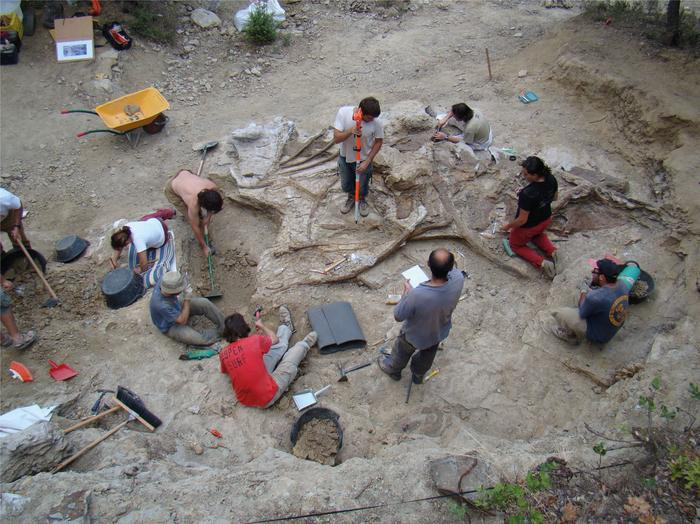One of Europe’s greatest concentrations of sauropod bones from the early Cretaceous has yielded a new gigantic dinosaur species. Even with bits of three individuals, most of the bones are still missing, but what has been found is enough for palaeontologists to recognize this is a species they have never seen before, and call it Garumbatitan morellensis.
Having pieces of three members of the same new species sounds like a palaeontologists’ dream, but even combined the pieces represent such scattered parts of Garumbatitan’s body that the discoverers are not game to estimate its size. Nevertheless, there is little doubt we are dealing with one hefty beast.
“One of the individuals we found stands out for its large size, with vertebrae more than one meter [3.2 feet] wide, and a femur that could reach two meters [6.6 feet] in length,” said team leader Dr Pedro Mocho of the University of Lisbon in a statement. “We found two almost complete and articulated feet in this deposit, which is particularly rare in the geological record.”
Garumbatitan was found in the Sant Antoni de la Vespa site in Valencia, where some of Spain’s first dinosaur bones were discovered. These bones were found in a 122 million-year-old stratum and clearly belong to a titanosaur, the largest animals to ever walk the Earth.

Palaeontologists Sant Antoni de la Vespa dwarfed by the bones they are extracting.
Image credit: GBE-UNED
Besides the femur the bones include some vertebrae, ribs, parts of the pelvis, and two nearly complete feet from the same large individual, while the almost complete hind limbs are from smaller individuals. Recognizing a new species sometimes requires a skull, but in Garumbatitan’s case the femur (upper leg bone) and foot bones are shaped differently from anything anyone has seen before, for example a “markedly developed lateral bulge” in the femur. Despite the differences in size, the commonalities of the various hind legs indicate these were all from the same species.
Besides revealing yet another ancient heavyweight, the discovery indicates there was more transcontinental movement among these giant beasts than previously determined. A fourth, apparently unrelated, sauropod was found in the same deposit, suggesting the area could support multiple giants.
Between them, Garumbatitan and the other sauropod show resemblances to species found in North America, Asia, and Africa.
“Our study highlights the enormous complexity of the evolutionary history of sauropods from the European Cretaceous – in particular, from the Iberian Peninsula,” Mocho said, indicating the dispersal between continents at a time when Pangea was just starting to break up.
Exactly where Garumbatitan fits on the sauropod family tree remains unclear, but one proposal places it close to Tastavinsaurus sanzi. If that doesn’t help you much, the nearest familiar name is probably Brachiosaurus a few steps further away.
The bones were found at the base of Mola de la Garumba, a high point in the region, so the genus name means “giant of Garumba.” The species name refers to Morella, the nearest town to the deposit.
The study is published in the Zoological Journal of the Linnean Society.
Curious about nature? Join us for our first-ever free virtual festival of science, CURIOUS Live, where we talk queerness in nature with science writer Josh Davis. Streaming online on October 21, 2023, we have a line-up of fascinating experts discussing all things Life, Death, and Creation (y’know, the small stuff) across three festival “stages”. Sign up now to find out more and secure your spot.
Source Link: Huge 122-Million-Year-Old New Dinosaur Described From Its Toes And Femur